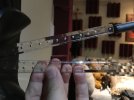I got inspired by an earlier thread here and decided to build my own sphere shaped speakers too
The idea is the same, I will be using the largest Ikea Blanda Matt bamboo salad bowls (having an outer diameter of 28cm)


The drivers will be Markaudio CHN110 full range models (I have used these beauties in a couple of earlier projects, they are one of the best full range drivers in this size)

Here is approximately how the cabinet will look like:

The xmax limited max input power will be approx. 150W at 80Hz and that will yield 106.4dB per speaker at 1m
(they will be crossed with the sub at 80Hz)

I will post more pictures as we proceed with the build with my neighbor
The idea is the same, I will be using the largest Ikea Blanda Matt bamboo salad bowls (having an outer diameter of 28cm)
The drivers will be Markaudio CHN110 full range models (I have used these beauties in a couple of earlier projects, they are one of the best full range drivers in this size)
Here is approximately how the cabinet will look like:
The xmax limited max input power will be approx. 150W at 80Hz and that will yield 106.4dB per speaker at 1m
(they will be crossed with the sub at 80Hz)
I will post more pictures as we proceed with the build with my neighbor















